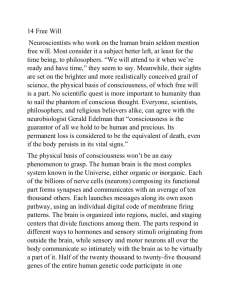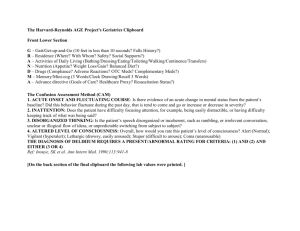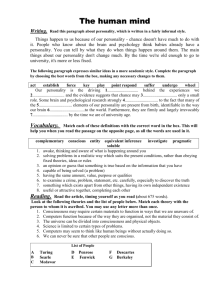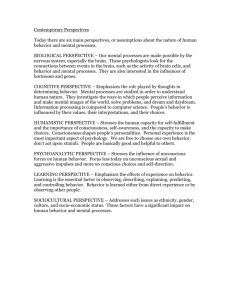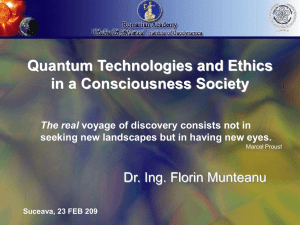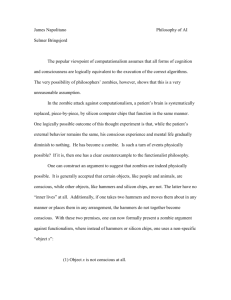Searle on biological naturalism
advertisement
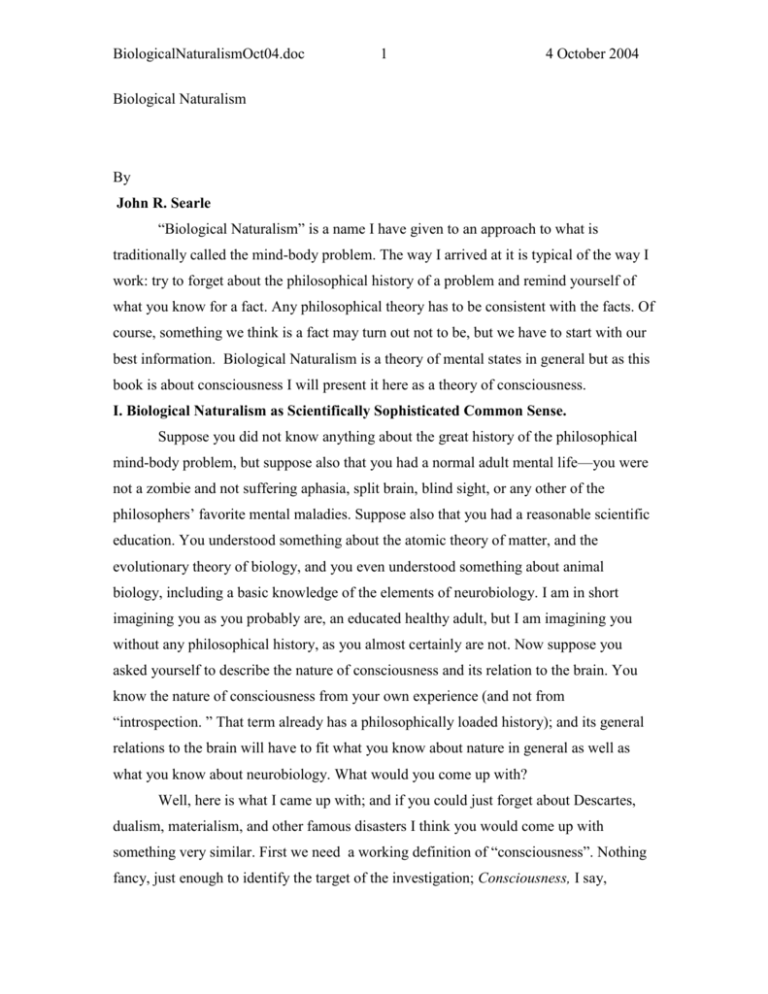
BiologicalNaturalismOct04.doc 1 4 October 2004 Biological Naturalism By John R. Searle “Biological Naturalism” is a name I have given to an approach to what is traditionally called the mind-body problem. The way I arrived at it is typical of the way I work: try to forget about the philosophical history of a problem and remind yourself of what you know for a fact. Any philosophical theory has to be consistent with the facts. Of course, something we think is a fact may turn out not to be, but we have to start with our best information. Biological Naturalism is a theory of mental states in general but as this book is about consciousness I will present it here as a theory of consciousness. I. Biological Naturalism as Scientifically Sophisticated Common Sense. Suppose you did not know anything about the great history of the philosophical mind-body problem, but suppose also that you had a normal adult mental life—you were not a zombie and not suffering aphasia, split brain, blind sight, or any other of the philosophers’ favorite mental maladies. Suppose also that you had a reasonable scientific education. You understood something about the atomic theory of matter, and the evolutionary theory of biology, and you even understood something about animal biology, including a basic knowledge of the elements of neurobiology. I am in short imagining you as you probably are, an educated healthy adult, but I am imagining you without any philosophical history, as you almost certainly are not. Now suppose you asked yourself to describe the nature of consciousness and its relation to the brain. You know the nature of consciousness from your own experience (and not from “introspection. ” That term already has a philosophically loaded history); and its general relations to the brain will have to fit what you know about nature in general as well as what you know about neurobiology. What would you come up with? Well, here is what I came up with; and if you could just forget about Descartes, dualism, materialism, and other famous disasters I think you would come up with something very similar. First we need a working definition of “consciousness”. Nothing fancy, just enough to identify the target of the investigation; Consciousness, I say, BiologicalNaturalismOct04.doc 2 4 October 2004 consists in all of one’s states of awareness. Awareness might seem too restricted, so just to be sure to cover all forms of consciousness, I flesh out the definition by adding awareness or sentience or feeling. And then I give an indexical component to the definition, to bring it down to concrete reality. I say: Conscious states are those states of awareness, sentience or feeling that begin in the morning when we wake from a dreamless sleep and continue throughout the day until we fall asleep or otherwise become “unconscious”. On this definition, dreams are a form of consciousness, though quite different from normal, awake consciousness. Having identified the target in general terms I now need to identify its essential features. Here are four of the most important. 1. Conscious states, so defined are qualitative, in the sense that there is a qualitative feel to being in any particular conscious state. This is the “what-it-feels-like” feature of consciousness. For example, tasting beer is qualitatively different from listening to Beethoven’s Third Symphony. Some philosophers use the word “qualia” to mark these qualitative states, but since consciousness and qualia are coextensive, it is unnecessary to introduce another expression. All qualia are conscious states, all conscious states are qualia. It is important to hammer this point home. There are not two kinds of conscious state, one qualitative, one nonqualitative. All conscious states are qualitative. 2. Such states are also ontologically subjective in the sense that they only exist as experienced by a human or animal subject. In this sense the tree outside my window has an objective ontology, but my conscious visual experience of the tree has a subjective ontology. The objectivesubjective distinction is ambiguous and we need to disambiguate it before we go any further. First, there is an epistemic sense of the objective-subjective distinction. The claim that Rembrandt was born in 1606 is a matter of objective fact. The claim that Rembrandt was a better painter than Rubens is a matter of subjective opinion. Objectivity and subjectivity in this epistemic sense are features of claims. But in addition to the epistemic sense there is an ontological sense of the distinction. Most things, such as mountains, molecules and tectonic plates exist apart from any experiencing subject. BiologicalNaturalismOct04.doc 3 4 October 2004 They have an objective or third person ontology. Some things, such as pains and tickles and itches, only exist when experienced by a human or animal subject, and they have a subjective or first person ontology. Consciousness is ontologically subjective in the sense that it only exists when experienced by a human or animal subject. It is important to emphasize that you can have epistemically objective knowledge of a domain that is ontologically subjective. It is for this reason that an epistemically objective science of ontologically subjective consciousness is possible. 3. Furthermore, a striking fact, at any moment in your conscious life all of your conscious states are experienced by you as part of a single unified conscious field. Your conscious states at any moment are parts of a single big conscious state. The visual experience of the tree, the tactile experience of the desktop under my hand, and the sight of the moon outside my window are parts of a single total conscious experience. But other entities in the world are not like that. The tree, the desk, and the moon are not in that way parts of a single total big object. Features 1-3, qualitativeness, subjectivity and unity, are not separate and independent. For a state to be qualitative in this sense implies that it is subjective. For a state to be qualitative and subjective implies that it is part of a unified field of qualitative subjectivity, even if it is the only thing in the field. If you try to imagine your present conscious field broken into seven parts you will find yourself imagining not one conscious field in seven pieces, but rather seven separate conscious fields. 4. Most, but not all, conscious states are intentional, in the philosopher’s sense that they are about, or refer to, objects and states of affairs. I said we were going to forget about the history of the subject and just state facts we all know. “Intentionality” is a word with a sordid history, so forget about the history if you can. (Forget about, “Intentionality is the mark of the mental” and other famous mistakes.) My states of thirst, hunger, and visual perception are all directed at something and so they fit the label of being intentional in this sense. Undirected feelings of well being or anxiety are not intentional. BiologicalNaturalismOct04.doc 4 4 October 2004 So now we have a definition and a description of some of the essential features. What more can you say? Well, if we are going to be careful we want to block some possible misunderstandings. We need to add: Consciousness so defined does not imply self-consciousness. You can be conscious of something without a higher order consciousness that you are conscious of it. Also, you do not need a general second order consciousness to have a first order consciousness. You can feel a pain, without necessarily reflecting on the fact that you are feeling a pain. So far we have identified are target, described its essential features and even blocked some misunderstandings. Now we need to say how it fits into the rest of the real world. 1. The reality and irreducibility of consciousness. Conscious states, so defined, are real parts of the real world and cannot be eliminated or reduced to something else. Often when we get a complete causal explanation of something we can show that it can be eliminated as an illusion – this happened with sunsets and rainbows, for example – or that it can be reduced to some more basic phenomena; it can be shown to be nothing but some micro phenomena – this happened to liquidity and solidity, for example. With consciousness we can neither eliminate it nor reduce it to something else. We can eliminate something when we show that the epistemic basis for it was an illusion. At dusk it looks like the sun is setting over Mt. Tamalpais and, when we see a rainbow, it looks like there is an arch in the sky, but in both cases the appearance is an illusion generated by more basic real phenomena – the rotation of the earth on its axis relative to the sun and the refraction of light rays by water vapor. But we can’t do this eliminative reduction with consciousness, because the epistemic basis is the reality itself: if it consciously seems to me that I am conscious then I am conscious. We can make lots of mistakes about our own consciousness, but where the very existence of consciousness is in question we can’t make the appearance-reality distinction, because the appearance of the existence of consciousness is the reality of its existence. BiologicalNaturalismOct04.doc 5 4 October 2004 We cannot do an ontological reduction of consciousness to more fundamental neurobiological processes, for a reason that is implicit in what I have already said: consciousness has a subjective or a first person ontology, the neurobiological causal basis of consciousness has an objective or third person ontology. You can’t show that a first person ontology is nothing but a third person ontology. I will say more about this point later. The causal reducibility of consciousness leads to our next point. 2. The neuronal basis of consciousness. All conscious states are caused by lower level brain processes, We do not know all the details of exactly how consciousness is caused by brain processes, but there is no doubt that it is in fact. The thesis that all of our conscious states, from feeling thirsty to experiencing mystical ecstasies are caused by brain processes is now established by an overwhelming amount of evidence. Indeed the currently most exciting research in the biological sciences is to try to figure out exactly how it works. What are the neuronal correlates of consciousness and how do they function to cause conscious states? The fact that brain processes cause consciousness does not imply that only brains can be conscious. The brain is a biological machine, and we might build an artificial machine that was conscious; just as the heart is a machine, and we have built artificial hearts. Because we do not know exactly how the brain does it we are not yet in a position to know how to do it artificially. 3. The neuronal realization of consciousness. All conscious states are realized in the brain as higher level or system features. Everything that has a real existence has it in a single space/time continuum and the real existence of consciousness is in human and animal brains. But conscious experiences do not exist at the level of individual neurons and synapses. Thoughts about your grandmother, for example, are caused by neuron firings and they exist in the brain as a feature of the system at a higher level than that of individual neurons. BiologicalNaturalismOct04.doc 6 4 October 2004 4. The causal efficacy of consciousness. Conscious states, as real parts of the real world, function causally. Typically, for example, when I make a conscious decision to raise my arm and my arm goes up, my decision caused my arm to go up. As with all physical systems, the brain admits of different levels of description, all of which are causally real levels of one and the same causal system. Thus we can describe my arm going up at the level of the conscious intention-in-action to raise my arm, and the corresponding bodily movement, or we can describe it at the level of neuron firings and synapses and the secretion of acetylcholene at the axon endplates of my motor neurons, just as we can describe the operation of the car engine at the level of piston cylinders and spark plugs firing, or we can describe it at the level of the oxidization of hydrocarbon molecules and the action of metal alloys. In both the case of the brain and the case of the car engine, these are not separate causal structures; it is a single causal structure described at different levels. Once you see that the same system can have different levels of description which are not competing or distinct, but rather different levels within a single unified causal system, the fact that the brain has different levels of description is no more mysterious than that any other physical system has different levels of description. I have now given a definition of consciousness, a brief account of some of its most important structural features, and a general statement of its relations to the brain and other parts of the real world. At one level, this amounts to a proposed solution, or perhaps better a dissolution, of the traditional mind-body problem. The views I have advanced, are, appropriately understood, matters of scientific common sense in that they are, I believe what one would say if one had a modicum of scientific knowledge but was free of the traditional philosophical categories. Notice that in advancing the views I put forward, I made no use of the traditional philosophical vocabulary. None of the famous theories and issues were mentioned, such a dualism, materialism, epiphenomenalism, Cartesianism, or all the rest of it. If you take seriously the so-called “scientific world view” and forget about the history of philosophy, the views I put forward are, I believe, what you would come up with. To have a name, I have baptized this view, Biological Naturalism. “Biological” because it emphasizes that the right level to account for the very existence of BiologicalNaturalismOct04.doc 7 4 October 2004 consciousness is the biological level. Consciousness is a biological phenomenon common to humans, and higher animals. We do not know how far down the phylogenetic scale it goes but we know that the processes that produce it are neuronal processes in the brain. “Naturalism” because consciousness is part of the natural world along with other biological phenomena such as photosynthesis, digestion or mitosis, and the explanatory apparatus we need to explain it we need anyway to explain other parts of nature. Sometimes philosophers talk about naturalizing consciousness and intentionality, but by “naturalizing” they usually mean denying the first person or subjective ontology of consciousness. On my view, consciousness does not need naturalizing: It already is part of nature and it is part of nature as the subjective, qualitative biological part. Just so I do not sound like I am talking about something abstract and ethereal let me nail the whole discussion down to reality with a real life example. Right now I feel a conscious desire to drink a cold beer. This desire is real in the sense that it cannot be shown to be an illusion or reduced to something else. This desire is subjective in the sense that it has first person ontology, the desire is qualitative in the sense that it has a certain qualitative feel to it, and it is definitely intentional in the sense that is directed at or about beer drinking. Furthermore it occurs as part of my total conscious field at the moment. My current feeling of desire is entirely caused by brain processes, it is located in the brain and it will very soon function causally by motivating me to go the refrigerator and pour myself a glass of cold beer. II. Objections to Biological Naturalism from the Point of View of the Philosophical Tradition If you find this account of consciousness so obvious as to be hardly worth stating, you are already a healthy biological naturalist and can probably stop reading now. However, though I think biological naturalism is contemporary scientific common sense, it is routinely challenged by those who accept some or all of the grand philosophical tradition of discussing the mind/body problem, and I now need to address the elements of that tradition that make it difficult to understand biological naturalism. BiologicalNaturalismOct04.doc 8 4 October 2004 The tradition that blinds us to these facts is vast and deeply embedded in our culture, both our popular culture and our academic philosophy. I cannot expose and answer all of it, but I will try to pick some of the central points. My strategy will be to make a series of objections to biological naturalism, and then show how they can be answered once we abandon certain false elements of the tradition. Objection 1. You cannot have it both ways. You cannot claim that consciousness is an ordinary biological process and thus have a materialist account of consciousness, but at the same time claim that it is irreducibly subjective, which gives you a dualist account of consciousness. You have to be either a materialist or a dualist—you cannot pretend to avoid both or to be both. Answer to Objection 1. Objection 1 rests on a mistaken conception of the implications of the real distinction between mental and physical. The traditional assumption is that mind and body, as ordinary understood, name mutually exclusive metaphysical categories. If something is mental then it cannot in that very respect be physical. If it is physical it cannot in that very respect be mental. This is the deepest mistake and it is shared by both materialists and dualists. Dualists think once you respect the reality and irreducibility of consciousness you are forced to dualism, materialists think once you accept a scientific naturalistic conception of the universe you are forced to deny the reality and irreducibility of consciousness. They are both trying to say something true but they end up saying something false. There is nothing for it but to expose the falsehood and rescue the truth. If we leave out some special problems about unconscious mental states, we can articulate the traditional picture in the following chart: On the traditional conception if anything is mental it has the left hand features, if physical, the right hand features. Mental Physical 1. Subjective Objective 2. First person ontology Third person ontology 3. Qualitative Quantitative 4. Intentional Nonintentional 5. Not spatially located & Spatially located & BiologicalNaturalismOct04.doc 9 4 October 2004 6. Non extended in space Spatially extended 7. Not explainable by physical processes Causally explainable by microphysical processes. 8. Incapable of acting causally on the physical Acts causally and as a system is causally closed. This chart embodies one of the deepest mistakes in our philosophical tradition and once you lay it out in its full nakedness you can see the mistake: the first half of the left hand column, 1-4, does not imply the second half, 5-8. Consciousness does indeed have 1-4. It is irreducibly subjective and in that sense has a first person ontology. It is qualitative in the sense that there is a qualitative feel to every conscious state. It is in many cases intrinsically intentional. But consciousness does not have features 5-8. As far as we know anything about how the world works, all such conscious states are spatially located in the brain. (Indeed with current imaging technology we are starting to discover something about their locations and spatial dimensions,) they are entirely caused by brain processes and like any other higher level feature of a physical system they are capable of functioning causally. The traditional notion of the mental, that distinguishes it from the physical, contains a serious mistake. The essence of consciousness, that it is subjective qualitative, first personal and intrinsically intentional does not prevent it from being an ordinary part of the physical world with spatial locations and extensions and cause and effect relations, just like anything else. The first and most important step in overcoming the traditional mind-body problem is to recognize that the intrinsic features of consciousness, its subjectivity, first person ontology and intentionality do not prevent it from being a biological feature of the world and thus located spatially in the brain and caused by brain process while itself capable of acting on other brain and bodily processes. Consciousness, though irreducibly mental (features 1-4 on the left) is, in that very respect, physical (features 5-8 on the right). But because the vocabulary has become so philosophically corrupt I suggest we abandon the traditional terminology of “mental” and “physical” and just say that consciousness is a higher level biological feature of brain systems. BiologicalNaturalismOct04.doc 10 4 October 2004 This is the most important objection I am going to make to the tradition in this article. The essential features of consciousness are in no way inconsistent with its biological and therefore causal part of three dimensional empirical reality. Objection 2. Biological Naturalism cannot avoid the charge of epiphenomenalism. The physical universe is “causally closed,” and if consciousness is irreducible to the physical or material universe, then it can have no causal effects on the physical universe. Answer to Objection 2. It is because of the mistake of accepting the dualistic categories that there even seems to be a problem about epiphenomenalism. Typically higher level features of a system, such as for example the solidity of the hammer, function causally even though the higher level feature is itself entirely caused by and realized in the system of microelements. When the hammer hits the nail, you can tell the causal story, as you would in real life, at the level of weight, solidity and velocity. Force equals mass times acceleration. But when the macro push comes to the micro shove the story could also be told at the level of the molecules and energy transfer at the molecular level. These are not two independent stories, but descriptions at different levels of one continuous causal system. No one in her right mind would say that solidity is epiphenomenal on the grounds that it has a microphysical explanation. Exactly analogously when you decide to raise your arm you can tell the story at the level of the intention and the bodily movement but you could also tell the story at the micro level, the level of neuron firings in the motor cortex and the secretion of acetylcholine at the axon end plates of the motor neurons. These are not two independent stories, but descriptions at different levels of one continuous causal system. No one who was not in the grip of the Cartesian categories would ever think there was a problem about epiphenomenalism. Objection 3. Your account seems to be self-contradictory. Is it reductionist or not? On your account, consciousness is clearly causally reducible, because it is entirely caused by neuronal processes, and it has no causal powers beyond those of neuronal processes. But at the same time, though you grant that it is causally reducible, you deny that it is ontologically reducible. You deny that consciousness can be reduced to physical processes and you insist, like old-time dualists, that it is “something over and above” the physical or material processes. BiologicalNaturalismOct04.doc 11 4 October 2004 Answer to Objection 3. Objection 3 rests on a mistake about reduction. In one crucial respect the analogy with solidity is inaccurate. Solidity can be ontologically reduced to molecular behavior and consciousness cannot be reduced to neuronal behavior. To put the point more precisely, in the case of solidity the fact that we can give a complete causal explanation of solidity in terms of micro physical processes leads us to say that solidity is nothing but a certain sort of microphysical phenomenon. Causal reduction leads to ontological reduction. But in the case of consciousness we are unwilling to make the ontological reduction. Consciousness is entirely caused by neuronal behavior, but all the same we are unwilling to say that consciousness is nothing but neuronal behavior. Why not? In the case of solidity we do not regard the surface features—such features as how solid objects feel, that they resist pressure, that they are impenetrable by other solid objects, etc.—as essential to solidity. So we carve them off and set them on one side and redefine solidity in terms of the micro causes of the surface features. Causal reduction leads to ontological reduction by redefinition. This reduction does not show that the surface features do not exist, but it simply excludes them from the essence of solidity. Well, why could we not do that with consciousness – carve off the surface features of what conscious states feel like and redefine them in terms of their micro-causes? We could, and if we knew enough, for certain purposes, say medical purposes, we might. We could then say, “This guy is in pain, even though he does not feel it yet. The thalamocortical system definitely shows the presence of pain, though it is unfelt” Just as we can now say, “Glass is really liquid, though on the surface it looks and feels solid.” But even if we did this reduction we would still need a vocabulary to name the first person subjective qualitative features of consciousness, just as we still need a vocabulary to name the surface features of solidity. Because the whole point of having our conceptual apparatus for discussing conscious states is to describe a first person ontology, we are reluctant to carve off this ontology and redefine the notion in terms of its third person causal basis. In the case of consciousness the causal reduction does not lead to an ontological reduction by redefinition, because the redefinition would take away the point of having the concept in the first place. BiologicalNaturalismOct04.doc 12 4 October 2004 In earlier writings, I said that the irreducibility of consciousness was a trivial consequence of our definitional practices. That remark was widely misunderstood, and I think the misunderstanding was probably my fault, so let me clarify it here. Grant me that consciousness exists as a first-person phenomenon in a world composed almost entirely of third-person phenomena and where, indeed, at the micro level the world is entirely constituted by third-person physical particles in fields of force. Then why is consciousness not reducible in the way that, for example, liquidity, solidity and color are reducible? Well, if you look at the reduction in the case of, let us say color, pretheoretically, we defined color in terms of how things look. Red is defined as what looks red to normal observers under normal circumstances. That seems circular, but it is not really because red can be defined ostensively and we can give a non circular account of “normal observr”. But once we discover the causal basis of the experience of red, we can redefine the color in terms of the reflectances that typically produce that experience. We carve off the experience of red and set it on one side and redefine the concept in terms of its causal base. The causal reduction leads to an ontological reduction by redefinition, by carving off the subjective component. Now, as I argued above, we cannot really do that with consciousness without losing the point of having the concept in the first place, so the asymmetry between consciousness and color is not an asymmetry in the basic structure of the universe. On the contrary, the two cases are symmetrical. The physics of colored objects, together with our constitution, cause us to have experiences of color, and the physics of our brain together with its biological constitution cause us to have the experiences of consciousness in general. But we are willing to make the reduction in the case of color in a way that we are unwilling to make it in the case of consciousness because we would lose the point of having the concept of consciousness in a way that we do not lose the point of having the concept of color if we make the reduction. That is what I meant when I said that the irreducibility of consciousness is a trivial consequence of our definitional practices. However, this remark produced a lot of misunderstandings so it is better to withdraw it and just describe the facts. Objection 4. You are still involved in inconsistencies. You say that consciousness is caused by brain processes. But if consciousness is really caused by brain processes, then BiologicalNaturalismOct04.doc 13 4 October 2004 there must really be two different things there: the brain processes as a cause, and the consciousness as an effect. And that is dualism. Answer to Objection 4. Objection 4 rests on a mistake about causation. We have been taught by Hume that causation is always a relation between discrete events ordered in time and that every singular causal relation is always an instantiation of a universal causal regularity. Lots of causal relations are like that, but not all. Many causal forces are continuous through time. Gravity, for example. The causal explanation of why this table exerts pressure on the floor is the force of gravity, but gravity does not consist of a sequence of discrete events. And lots of causal relations are bottom up and simultaneous with the effect. For example, the causal explanation of why this table supports objects is in terms of the behavior of the microparticles, but the causal explanation of why the table supports objects is not given by first specifying one event, the molecular movements, and then a later event, the support of the object. Rather the two are simultaneous. Similarly the causal explanation of why my brain is in its present state of consciousness is in terms of, let us suppose, massive rates of synchronized neuron firings at synapses. But this does not require that, first, the brain behave in a certain way and then, later, consciousness exists, rather the conscious states are realized simultaneously with the neuron firings. III. Conclusion I said that both dualism and materialism are trying to say something true but because of the philosophical tradition they end up saying something false. Which part is false and which true? Dualism says truly that consciousness is a real feature of the real world and is neither eliminable nor reducible to something else. But it says falsely that consciousness is not an ordinary part of the physical world we all live in, but it inhabits a separate metaphysical realm. Materialism says truly that the universe consists entirely of physical particles in fields of force (or whatever the ultimately true physical theory says are the basic building blocks of the universe) but it says falsely that consciousness as an irreducible, subjective, qualitative mental phenomenon does not exist. One way to see Biological Naturalism is as an attempt to preserve what is true in each while discarding what is false. In order to do that we have to overthrow a set of powerful philosophical presuppositions BiologicalNaturalismOct04.doc 14 4 October 2004 Given a choice between the facts as we know them—consciousness exists, it is caused by neuronal processes, it exists in the brain, and it has causal functions in the life of the organism—and various philosophical theories, I will take the facts any time. Furthermore, I am confident that in the long run, the facts will prevail over the theories which will come to seem more and more obsolete. It is worth pointing out that practicing neurobiologists of my acquaintance, such as Francis Crick, Gerald Edelman and Cristof Koch, implicitly or explicitly accept a version of what I have been calling biological naturalism. They look to the operations of the brain to find an explanation of consciousness. It will probably take a long time before Biological Naturalism is generally accepted by the academic profession because we follow a long tradition of teaching our students the mistaken view that this is a philosophical problem of impossible difficulty. But notice that we have to train our students to think there is an impossible mystery as to how neuronal processes could cause conscious states. It is not a view that follows naturally either from reflecting on one’s own experiences or from studying brain operations. Once we overcome the mistakes of the tradition, I think the facts will fall naturally in to place.



